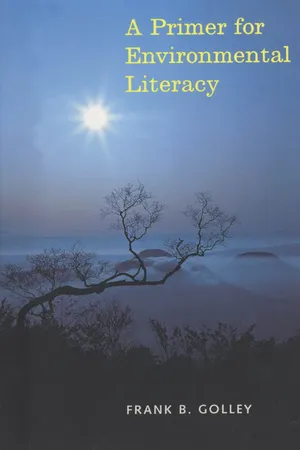
- English
- PDF
- Available on iOS & Android
A Primer for Environmental Literacy
About this book
This broad-ranging book presents the key concepts of environmental science in an accessible style that can be understood by those who are not natural scientists. It offers a way to improve environmental literacy—the capacity to understand the connections between humans and their environment.
Unique in its breadth and simplicity, the book is also unusual in that it uses a "top-down" approach, starting with a global scale and proceeding to smaller units of organization until it reaches the individual organism. It is divided into four parts. The first introduces three core concepts—the environment, the system, and environmental hierarchies—and applies these ideas to the earth as a system. The second focuses on land and water systems, beginning with the whole earth and ending with the ecotope (small-scale systems in which we work, live, and play). The third section is concerned with populations and individuals. The final section builds up from individuals to the biotic community. The book ends with an overview of human ecology and with general conclusions about the conditions of the biosphere. The book, which includes a reading list for each topic, is ideal for the student or general reader interested in learning more about the environment and how to value it.
Frank B. Golley is Research Professor, Institute of Ecology, at the University of Georgia. Past president of the Ecological Society of America and the International Association for Ecology, he was until recently editor of Landscape Ecology. He is the author of numerous books and articles, including A History of the Ecosystem Concept in Ecology, published by Yale University Press.
A selection of the Library of Science
Frequently asked questions
- Essential is ideal for learners and professionals who enjoy exploring a wide range of subjects. Access the Essential Library with 800,000+ trusted titles and best-sellers across business, personal growth, and the humanities. Includes unlimited reading time and Standard Read Aloud voice.
- Complete: Perfect for advanced learners and researchers needing full, unrestricted access. Unlock 1.4M+ books across hundreds of subjects, including academic and specialized titles. The Complete Plan also includes advanced features like Premium Read Aloud and Research Assistant.
Please note we cannot support devices running on iOS 13 and Android 7 or earlier. Learn more about using the app.
Information
Table of contents
- Contents
- Preface
- Introduction
- Cluster 1. Foundation Concepts
- Introduction
- 1. The Environment
- 2. The System
- 3. Hierarchical Organization
- Cluster 2. Land and Water Systems
- Introduction
- 4. The Ecosphere, with Comments on the Gaia Hypothesis and the Biosphere
- 5. Energy Dynamics
- 6. The Composition of the Earth
- 7. The Biome
- 8. The Landscape
- 9. The Watershed
- 10. The Ecotope
- 11. Species Diversity
- 12. Primary Production and Decomposition
- 13. Ecological Succession
- Cluster 3. The Population and the Individual
- Introduction
- 14. The Population as a Demographic Unit
- 15. Life-History Adaptations
- 16. The Individual Organism
- 17. Body Size and Climate Space
- 18. Speciation and Natural Selection
- Cluster 4. Interaction Between Individuals and Species
- Introduction
- 19. Interactions Between Individuals
- 20. Mutualism
- 21. Competition
- 22. Predation
- 23. Coevolution and Niche
- 24. The Bio tic Community
- 25. Island Biogeography
- 26. Human Ecology
- Conclusion: Ecology, Environment, and Ethics
- Literature Cited
- Index